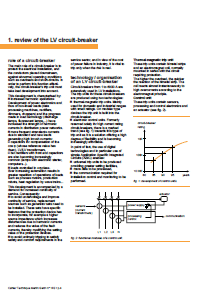Replacing thermalmagnetic trip units
Development of loads, a result of the technological breakthroughs of the last decade, has led to an increased number of constraints in electrical power distribution. Protection devices have had to adapt accordingly, particularly with regard to three phenomena:
- high harmonic currents due to multiplication of non-linear loads using power electronics (rectifiers, switch mode power supplies,…);
- transient currents caused by energising loads with a high inrush current such as capacitive loads, LV/LV transformers;
- cyclic currents resulting from a marked increase in load automatically in repetitive cycles (welding robots, wave train heating).
The purpose of this Cahier Technique is to show how electronic control units take these new requirements into account and tend to replace thermalmagnetic trip units. It also shows how the possibilities of digital technology have turned these control units into «intelligent, communicating» sensors/actuators.
Role of a circuit-breaker
The main role of a circuit-breaker is to protect the electrical installation, and the conductors placed downstream, against abnormal operating conditions such as overloads and short-circuits. In order to perform this function effectively, the circuit-breaker’s trip unit must take load development into account.
AUTHOR: Schneider Electric experts | Michel COLLOMBET, Bernard LACROIX
| Title: | LV circuit-breakers confronted with harmonic, transient and cyclic |
| Format: | |
| Size: | 0.01MB |
| Pages: | 16 |
| Download: | Right here | Video Courses | Membership | Download Updates |


